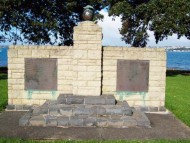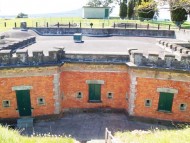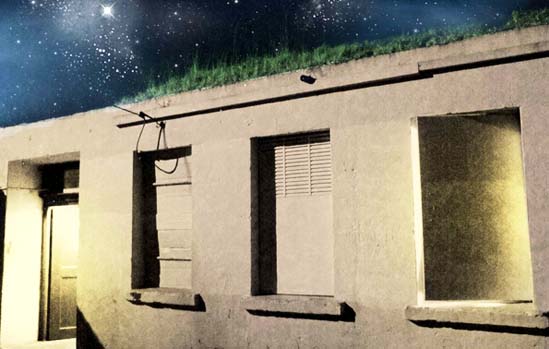Devonport History Trail
Devonport village is one of Auckland’s oldest areas, settled by Maori around the mid 14th century and later colonized by the Pakeha. Due to the location of Devonport, the village became an important farming and shipbuilding centre with close links to New Zealand’s naval history.
The trail is a must-do for history buffs or those wanting to further explore the unique and fascinating history of the seaside village. The walk includes visiting two volcanic cones, providing perfect photo taking opportunities, with one of a kind views of Rangitoto Island, the Waitemata Harbour and the Hauraki Gulf.
You will also come across iconic Devonport buildings, showcasing the Victorian architectural features found throughout the village. Devonport is also home to a number of historic sites and memorials dedicated to commemorating Devonport’s unique part in New Zealand history. Download the history trail PDF to read about the trail in further detail.
The trail takes between two and three hours to complete, although it is up to you whether you spend more or less time at certain locations.
Flagstaff
The history trail begins at Devonport Wharf, where you can catch a ferry to or from Auckland’s CBD. Across the road to the right is Windsor Reserve, traditionally named Flagstaff due to its connections with the navy. It is here that the British navy landed and began the European settlement of Devonport in 1840. To mark the significance of this location a commemorative flagstaff and plaque can be observed near to the waterfront.
Boer war Arch memorial
Continue onto King Edward Parade, historically the industrial and ship building centre of Devonport and will find the Boer war Arch commemorating the fallen soldiers of the Boer War. The Arch beautifully frames the picturesque views of Auckland city and is a favourite for photographers.
Elizabeth House
On the left two identical and linked villa style buildings (Elizabeth House) can be found. The Navy originally used these as accommodation for the Women’s Royal NZ Navel Service and visitors can rent an apartment in this building for accommodation today.
Execution site
Further along King Edward Parade on the right hand side a public execution site can be found in this picturesque location overlooking the sea. It was near this area that Joseph Burns, the first European to be officially executed in New Zealand, both committed and was later hanged for his capital crime.
Ship building plaque
During the 19th century Devonport became the most important shipbuilding area in the North Island, if not New Zealand as a whole. Along the waterfront of king Edward Parade a plaque can be found to commemorate the shipbuilders who worked on this shore.
The Masonic Hotel
On the corner of Church St and King Edward Parade you’ll find one of New Zealand’s oldest Taverns, The Masonic. The Masonic was built in 1866 originally as a seaside resort, whilst today the Masonic is the perfect place to have a meal and take in the sea views. The Tavern is a unique heritage building symbolic of Devonport’s past.
Tainui memorial
Erected in 1959, Tainui Memorial can be found on the right hand side next to Torpedo Bay as a commemoration of the great waka Tainui. The Tainui was one of seven wakas that carried the first Maori from Hawaiiki to New Zealand. The memorial is a replica of the sacred bird image Korotangi (weeping dove) that was brought on the waka Tainui.
Arrival of the French
Further along a plaque commemorates the visit by the French corvette L’Astrolabe in 1827 and its commander, Dumont D’Urville, who climbed Mt Victoria to survey the harbour.
Torpedo Bay Naval Museum
At the end of King Edward Parade, Torpedo Bay Naval Museum is the perfect place to learn more about The Royal New Zealand Navy and its shared history with Devonport. The site of the museum is historical itself, developed in the 19th century as a part of Auckland’s coastal defence network. Inside these heritage buildings are a number of excellent displays and one of New Zealand’s largest collections of naval history resources.
Continue your walk up to the North Head Historical Reserve for stunning views and links to Devonport’s military past.
North Head
North Head is a volcanic cone and previously a Maori pā before European colonization. A military tunnel complex and gun emplacements were built during 1885 and North Head features some of the few remaining disappearing guns in the world. As well as links to the military, North Head is known for its stunning views of Rangitoto Island, the Waitemata harbour and the Hauraki Gulf. After exploring North Head walk along the pretty streets of Tainui Road turning left onto Vauxhall Rd and take the first right onto Albert Road. This leads you to Mt Victoria- another volcanic cone and spectacular view point.
See our North Head Historic Reserve Trail page for more details.
The grave of Eru Patuone
Just past the Lake Road roundabout you will find the old Devonport cemetery. Inside is the grave of Maori Chief Eru Patuone (the peacemaker). Eru Patuone was born in 1764 and lived for over 108 years, until 1872. Patuone lived during the early years of Pakeha settlement in New Zealand and thus witnessed and played a role in a number of key events that shaped modern New Zealand. Patuone was known as the peacemaker due to his relationships with both Maori and Pakeha and his role as a mediator between them. During his life Patuone had a relationship with all of New Zealand’s Governors and was consulted by them regarding Pakeha Maori relations.
The upper slopes of Mt Victoria can be reached via a number of different grass trails, however these become more challenging in the winter months. To reach the main entrance of Mt Victoria come back out onto Albert road and continue walking, at the end turn left onto Victoria Road. Continue down Victoria Road and take the slight left onto Kerr Street. On the right you will find the main entrance to Mt Victoria, the highest volcanic cone on Auckland’s north shore.
The signalman’s’ house
Walking further up Mt Victoria on its upper slopes you will find a signal station, which in the past was used to inform residents about the arriving and departing ships. Many houses in the Devonport area were built to provide a direct line of site to the signal station so the inhabitant’s could easily read the flags. Whilst the first signalmen lived in a tent or hut, later a Victorian styled villa was built to house the signalman and his family. The last signalman to live in this villa passed away in 1943.
Mount Victoria
Mt. Victoria is the highest of Devonport’s volcanic cones, first occupied by a Maori pā (Maori village or defence settlement) and later developed by Europeans as a means of protection from invasion. Evidence of the mountain’s historical uses such as pā terraces and pits, and one of Devonport’s disappearing guns can still be seen on the slopes today. With some of the best views in Auckland, the top of Mt Victoria provides a panoramic scene of the Waitemata Harbour and Hauraki Gulf, unique to this viewing point.
Victoria picture palace
After walking down Mt Victoria you will come out onto Kerr Street Continue along this street and turn left at the end onto Victoria Road, the heart of Devonport. Almost immediately on the left hand side you will come across Victoria Picture Palace.
Built during the silent movie era, the Victoria Picture Palace is the earliest purpose built cinema still in existence in the southern hemisphere. The picture palace has changed ownership several times throughout its life, and is now leased by the Victoria Theatre Trust who intends to maintain the cinema and performance venue.
BNZ bank vault – Patriot
Remaining on the left hand side and walking down towards the water you will see The Patriot, Devonport’s only British themed pub. The pub is situated in the historic Bank of New Zealand building, with its original safe vault as a focal point of the main room. Its historic setting and atmosphere provides the perfect place to enjoy a cold drink or snack.
Post office building
The building on the right next to the Patriot is Devonport’s old post-office building. The art deco styled building was purpose built and used as a post office until the early 1980’s when it was sold to house a museum. Although the old post office has recently undergone a major transformation to create retail and office spaces, the building has maintained its historical integrity and remains an iconic building of Devonport village.
The Esplanade Hotel
At the foot of the right hand side of Victoria Road you will come across the Esplanade hotel, a large cream building. Built in 1903 and modeled on English seaside hotels of the time, the Esplanade has been beautifully restored making it an icon of Devonport village. Opposite the Esplanade you’ll find yourself back at the Devonport Wharf where you take a quick ferry ride back to Auckland City.

Maori History Trail
FAMILY FRIENDLYThe Maori History Trail is a great introduction to the unique indigenous history of Devonport and its links to the settlement of Maori in Auckland. Discover the landing site of one of the first Maori Wakas to New Zealand, two Maori pā sites and the grave of esteemed Maori Chief Eru Patuone.
Fort Takapuna Devonport
FAMILY FRIENDLYFort Takapuna is a lookout point and bunker defence site and the last of the New Zealand designed twin 6 inch gun forts in existence. The fort is below ground level as originally a dry moat surrounded the fort on all sides, with a drawbridge to provide access.












